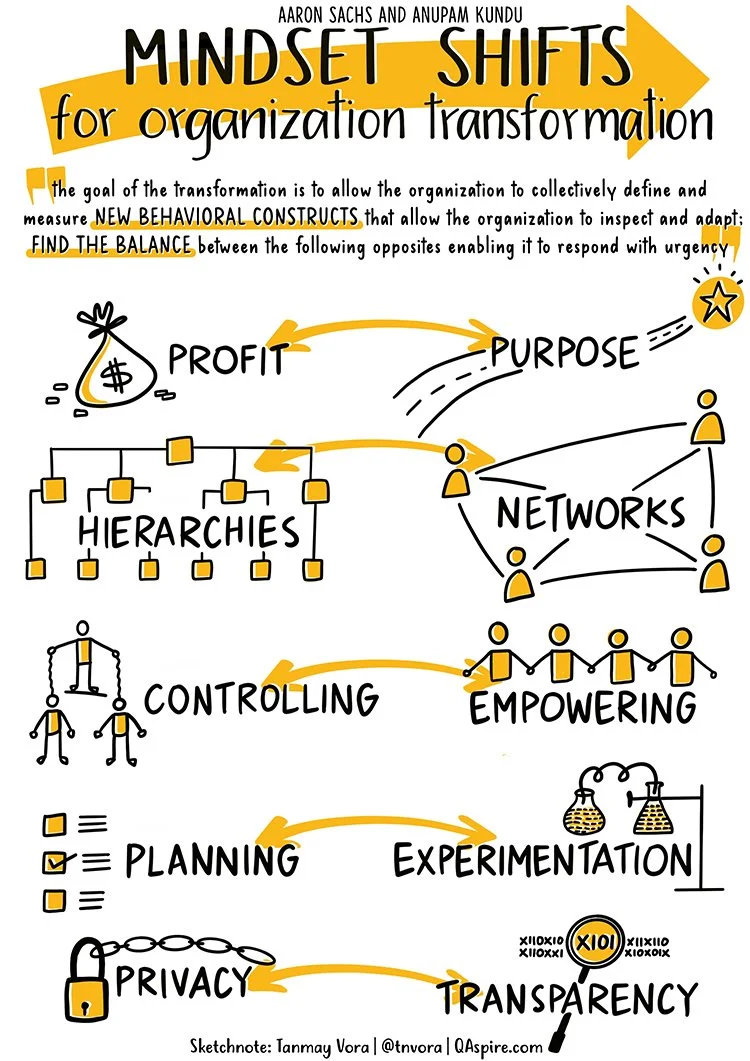A conversation with Eleanor Gibson, agile coach and founder of Tilt
Photo by Dan Roizer on Unsplash
Hello Eleanor. We hear about agile leadership and agile teams. How would you describe what this is and how it works?
Eleanor: Agile ways of working are exciting because they enable us to be more adaptable and impactful.
People are mostly used to thinking about teams as being agile. To me, an agile team is a small, autonomous, cross-functional group of people who are working in a way that is in line with agile principles; focused on validated user needs, in an iterative and transparent way.
Interestingly, a leader will often come to me and say "I need my team to be more agile!" But you need agile leadership for an agile team. So how can you adapt your leadership style? To me, agile leadership means focusing ruthlessly on outcomes over outputs. Your role is to hold the vision. Then getting out of the way so your team can work out the best way to deliver that. Agile leadership involves trusting and empowering people and having less control.
In order for a leader to move out of the way, team members need to be accountable to each other. I was thinking about Lencioni's model, the five dysfunctions and functions of a team. Sometimes there’s more collusion than colleagues keeping each other accountable. But then a good team leader can coach the team in how to be more accountable.
Eleanor: Agreed.
Eleanor, you say agile ways of working is a mindset focused around principles instead of something that you ‘do’. Can you say more about that?
Eleanor: Agile was born in the world of software development, but we work in the charity sector. We can’t just copy and paste from one world into another. Instead, what we need to do is apply the principles and values of agile working as a mindset.
Where we see teams and organisations struggling with embedding organisational agility, it’s usually because they’re focusing on the tactics, tools, and processes instead of using the principles and values to set up their organisation to thrive in the internet age.
I love this graphic of mindset shifts you showed me.
Mindset shifts for organisation transformation
Eleanor: Yes - this shows how when we are talking about agile as a mindset, what we are talking about are those shifts in focus from profit to purpose; from hierarchies to networks; from control to empowering, and so on. These shifts can happen on a team level or an organisational level. You can follow a prescribed methodology, doing sprints and standups but still not be any more agile. It's messier, but organisations who focus on agile as a mindset get the most value from it.
If you distil it to agile principles, then constant reflection and learning are built in – agile teams review not only what they’ve done, but also how they’ve worked as a team. That reflection on ways of working in order to make improvements is so important and often overlooked!
Eleanor: Yes. Many teams who have moved to more agile ways of working say that they spend more time thinking and talking about how they work and, perhaps counterintuitively, they find they get more meaningful work done! An agile team will have a really clear vision and will be running lots of quick experiments to learn what will best achieve their desired outcome.
To do that, you're really listening to what the data is telling you.
Eleanor: Exactly! Instead of a detailed work plan there'll be a vision and a list of the short-term things they want to try and test. The most agile organisations will not only be using the data from those tests to improve their approach, but also to adapt what that end goal is, based on what they learn. The world is changing so quickly that it's necessary.
Connie van Zanten says being agile is a means to an end, not an end in and of itself. Do you agree?
Eleanor: Definitely. Connie is my agile superhero!
We’re in the middle of massive changes, with the pandemic, and the cost of living, energy and climate crises. One of the benefits of being agile is the ability to adjust and respond. Do you know of examples where organisations used agile principles to deal with unexpected crises?
Eleanor: We’ve seen many charities in the UK use an agile approach to pivot the way that they raise money during the pandemic – from running online fundraising events to quickly adapting their fundraising asks to reflect the new world. For example Amnesty International UK’s Digital Engagement team had their most successful year ever during the pandemic in part due to cultivating more agile ways of working. Many have also used agile ways of working to adapt the way they deliver their services. For example, Action For Children were able to quickly set up a successful way of supporting parents online rather than in children's centres.
Save the Children also told me that because they're working in small, cross-functional agile teams, they've put together a fundraising campaign in six weeks that would usually take six months. Not to mention the higher levels of satisfaction and wellbeing.
Eleanor: Absolutely. Based on feedback with teams that we've worked with, agile teams report having better wellbeing and feeling more enthusiastic, empowered, confident, clear, committed, and connected.
Eleanor, one of the things you help organisations with is agile coaching. Can you explain a bit what it is and how it works?
Eleanor: Agile coaching is the best way to support teams and organisations to become more adaptable. It assumes the people and organisations involved are the experts in what they do.
Coaching is about learning by doing. Instead of spending loads of time talking about it, agile coaching allows you to just do it.
Eleanor: It's exactly that. Returning to that image of mindset shifts again, it's all about embedding agile ways of working in an agile way, by empowering, experimentation, and transparency rather than rigid training and telling.
Tell us about your Charity Agile Leaders Club – what have you noticed about this group of people and the things they have in common?
Eleanor: I know from experience that leading culture change can be lonely and hard. So at Tilt we invite folks together so they can support and learn from each other and also see the diversity of approaches. There isn't one right way to do things.
In the club there are people driving digital transformation or embedding agile ways of working in their purpose-driven organisations. They tell me they get so much value from sharing their unique experiences in a smaller, safer group, getting advice and sparking ideas from each other. The ultimate goal is for this to be one of the ways we support the whole of the charity sector in the UK to be a more efficient and enjoyable place to work.
I love the idea of a “constructive rant”! Can you say more about the value of this?
Eleanor: I love facilitating a constructive rant! It's a valuable way to create safer spaces for people to share what's pissing them off. Then use that to drive positive change. I've yet to find a place where it doesn't work!
You spend a couple of minutes in a pair ranting, then you flip your rant round and talk about what you want to happen instead. That gives you something you can action.
I do something similar in my solutions-focussed workshops. Telling people to “think positive” doesn’t work because people just need to speak their mind first, so we allow for ranting at the start. Then they discuss in groups what they want to happen instead. They always comment on how hard it is to use positive language, to say what they do want rather than what they don’t want. Then they think about what they can do in the next month, week, day to move towards that goal.
Eleanor: Part of the power comes from creating a space where focused ranting is welcome. And you're expected to create specific actions you’re accountable for.
The biggest challenge that I find for nonprofits is letting go of control and empowering teams. As a coach, I see some managers defaulting to effectively bullying people in order to build their own confidence. That thing you mentioned, Eleanor, about getting out of your team’s way is the ideal. You don't need your CEO to sign off a tweet! It's been really interesting to speak to Carmen Barlow from Amnesty who got to the stage where she doesn't need to sign off much.
Eleanor: Yes, it’s a massive change for many. School is all about command and control. There's one correct answer, and you do as you're told. Leading our teams and organisations to thrive in this technology-driven world requires a very different way of working to how we've been socialised.
Eleanor is the founder of Tilt.
A big thank you to Anya Pearson of Contentious for making this discussion happen.





